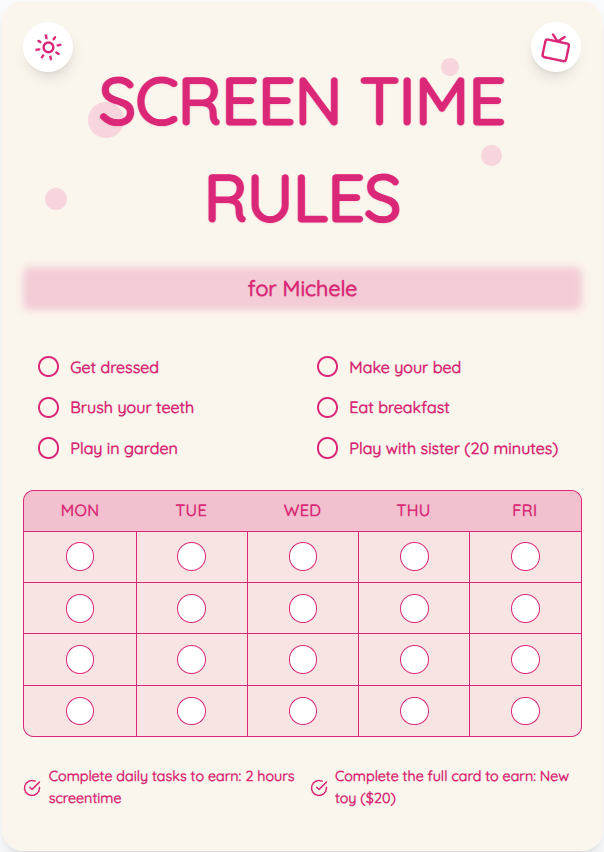Essential Screen Time Guidelines for Children Ages 2-12
As a parent, navigating the digital landscape and setting appropriate screen time limits for your child can be challenging. Understanding the recommended screen time guidelines per age group is crucial in promoting a healthy balance between screen use and other activities. Let's explore age-specific recommendations and practical tips to help you manage your child's screen time effectively.
See What Your Screen Time Chart Will Look Like
Here's an example of a beautiful, customizable screen time rules chart you can create for your family

Screen Time Guidelines for Children Ages 2-5
For preschoolers aged 2-5, the American Academy of Pediatrics recommends limiting screen time to one hour per day of high-quality programming. It's essential to prioritize interactive activities, outdoor play, and hands-on learning experiences for this age group to support their cognitive and physical development.
Screen Time Guidelines for Children Ages 6-12
School-aged children between 6-12 years old can benefit from up to two hours of screen time per day, focusing on educational content, creative platforms, and interactive games. Encouraging a balance between screen activities, physical exercise, and social interactions is key to fostering overall well-being.
Put These Tips Into Action
Create a custom chart to implement these strategies with your child
Setting Healthy Screen Time Habits
Establishing clear screen time rules and routines within your family can help create a harmonious digital environment. Encourage open communication about screen use, involve children in creating a screen time schedule, and model positive screen habits yourself. Emphasize the importance of quality over quantity when it comes to screen time.
Practical Tips for Success
- Create a screen time chart based on your child's age and daily schedule.
- Set designated 'no-screen zones' in your home, such as the dining area or bedrooms.
- Use parental control tools to monitor and limit your child's screen time effectively.
- Encourage alternative activities like reading, outdoor play, and creative hobbies.
Frequently Asked Questions
How can I handle pushback from my child when enforcing screen time limits?
Engage in open discussions with your child about the reasons behind screen time limits. Set clear expectations and consequences, and offer alternative activities to make the transition smoother.
What are the signs of excessive screen time in children?
Warning signs include irritability when screen time is interrupted, declining academic performance, disrupted sleep patterns, and lack of interest in non-screen activities.
Are educational apps and programs considered beneficial screen time?
When used in moderation and selected wisely, educational apps and programs can supplement learning experiences. However, it's essential to balance screen-based learning with hands-on activities and social interactions.
By following age-appropriate screen time guidelines, implementing practical tips, and fostering healthy screen habits, you can create a balanced digital environment that supports your child's overall development. Explore our customizable screen time charts at ScreenTimeRules.com to simplify the process of managing your child's screen time effectively.
Ready to Transform Your Family's Screen Time?
Join thousands of parents who have successfully managed screen time with our customizable charts.
